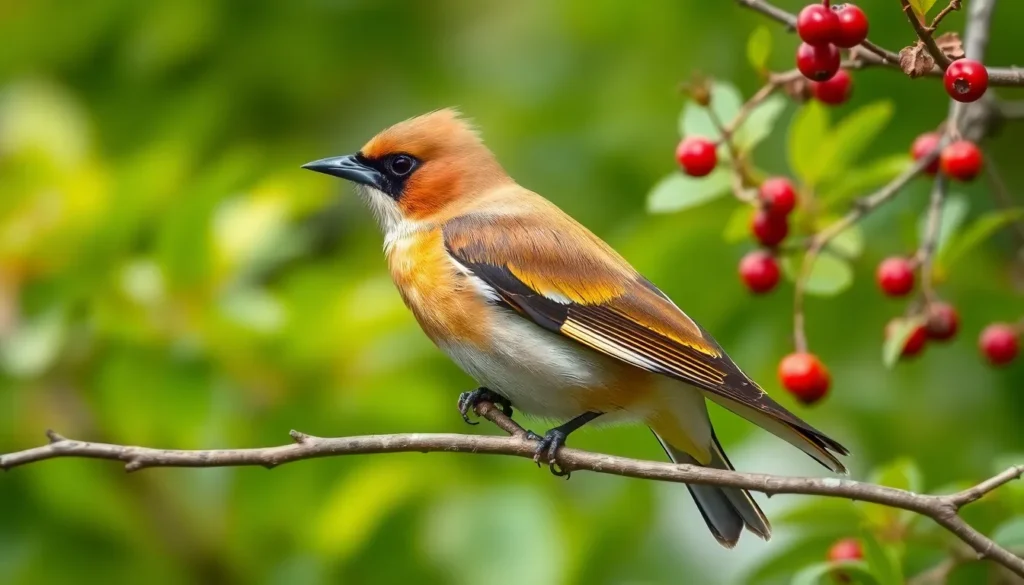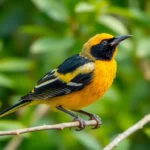When we spot a cedar waxwing gliding through our backyards, we’re witnessing one of North America’s most elegant songbirds in action. These sleek birds captivate us with their distinctive crested heads, silky plumage, and those iconic waxy red wing tips that give them their memorable name.
We’ve all heard their high-pitched calls echoing through neighborhoods, but there’s so much more to discover about these fascinating creatures. Cedar waxwings aren’t just pretty faces – they’re nature’s fruit connoisseurs with unique social behaviors that set them apart from other backyard visitors.
Whether you’re a seasoned birdwatcher or someone who’s just noticed these beautiful birds at your feeder, understanding cedar waxwings will transform how you view your local network. From their nomadic lifestyle to their remarkable ability to survive on fruit alone, we’ll explore what makes these birds truly extraordinary and how we can better appreciate their presence in our outdoor spaces.
Physical Characteristics and Identification
Cedar waxwings display remarkable consistency in their physical attributes across populations. We can identify these elegant birds through several distinctive features that make them unmistakable in the field.
Distinctive Features and Plumage
The silky brown plumage creates the cedar waxwing’s most recognizable characteristic. Adults showcase a pale yellow breast that gradually transitions into white undertail coverts. Black eye masks extend from the bill to behind the eyes, creating a distinctive facial pattern that contrasts sharply with their warm brown heads.
Waxy red tips appear on the secondary wing feathers, giving these birds their common name. These bright red appendages develop as birds mature, with older individuals typically displaying more prominent waxy deposits. Yellow tail bands create another identifying feature, appearing as bright terminal stripes across the tail feathers.
Pointed crests rise from the back of their heads, remaining visible even when slightly flattened during flight or feeding. The crests move expressively, often indicating the bird’s alertness or emotional state.
Size and Body Structure
Cedar waxwings measure between 6.5 to 7 inches in length with wingspans reaching 8.7 to 11.8 inches. Adults weigh approximately 1.1 ounces, making them comparable in size to house sparrows but with a more streamlined profile.
Their bodies exhibit sleek proportions with relatively short legs and medium-length tails. Wings appear pointed and designed for efficient flight, reflecting their nomadic lifestyle and need for sustained aerial movement. Bills remain short and slightly hooked, perfectly adapted for grasping berries and small fruits.
Seasonal Variations in Appearance
Adult cedar waxwings maintain consistent plumage throughout the year, showing minimal seasonal variation. Breeding season brings slightly more vibrant coloration, with yellow breast feathers appearing more intense and waxy red wing tips becoming more pronounced.
Juvenile birds display different characteristics during their first summer. Young cedar waxwings show streaked underparts with less defined facial masks and lack the distinctive waxy red wing tips. Gray-brown upperparts replace the rich brown coloration of adults, while yellow tail bands remain absent or very faint.
Molting occurs during late summer and early fall, when adults replace their flight feathers gradually. This process rarely affects their overall appearance dramatically, as feather replacement happens systematically rather than all at once.
Habitat and Geographic Distribution
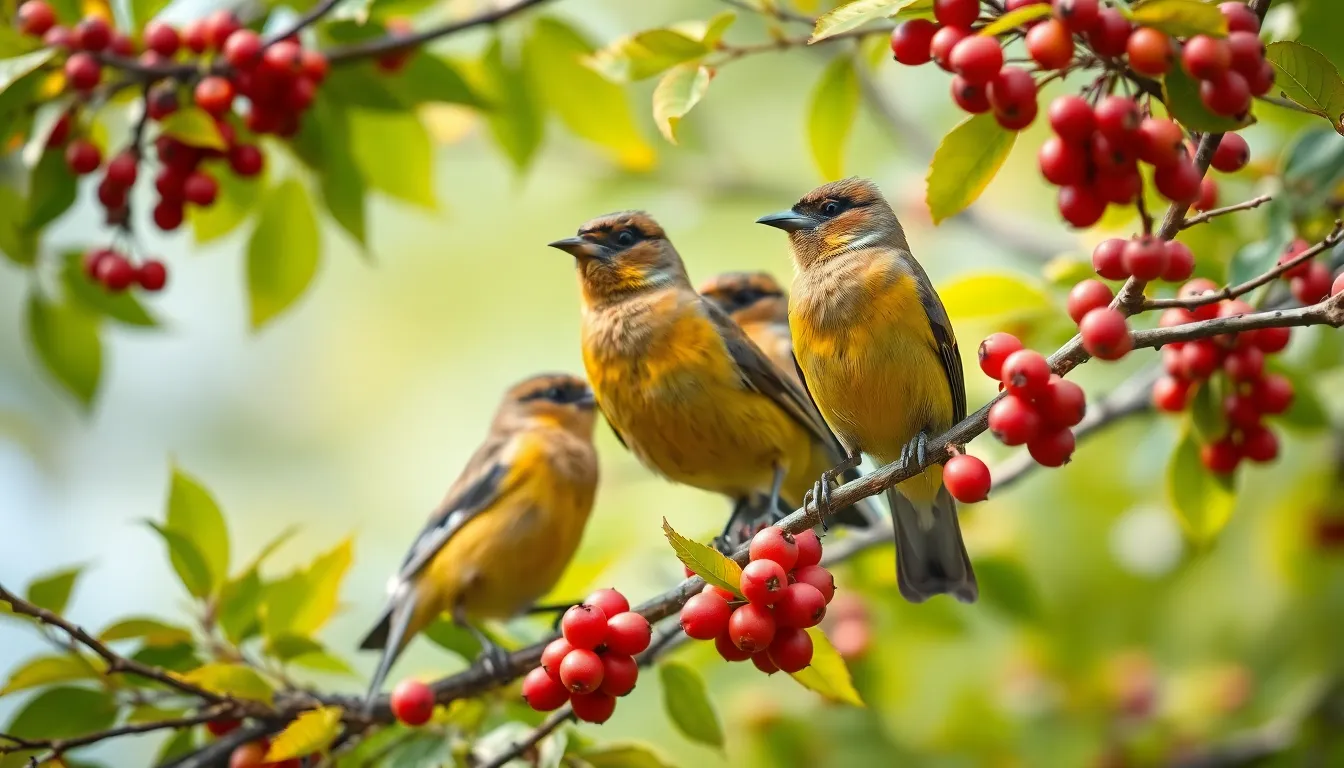
Cedar waxwings adapt to diverse environments across North America with remarkable flexibility. These nomadic birds demonstrate unique distribution patterns that set them apart from most songbird species.
Natural Range and Migration Patterns
Cedar waxwings breed across a vast range extending from southeastern Alaska through Canada and into the northern United States. Their breeding territory spans from British Columbia to Nova Scotia and south through the Rocky Mountains to New Mexico and across the eastern states to Georgia. During winter months, these birds migrate to southern regions including Mexico, Central America, and the Caribbean islands.
Migration patterns for cedar waxwings differ significantly from typical songbird behavior. Rather than following predictable seasonal routes, they practice nomadic movement based on food availability. Large flocks may appear in areas with abundant fruit crops, remaining for weeks before moving to new locations. This irregular migration makes cedar waxwings unpredictable visitors to exact regions from year to year.
Weather patterns and fruit production cycles drive their movement decisions. Harsh winters push northern populations southward, while mild conditions may keep some birds in northern territories year round. Eastern populations generally migrate shorter distances than western birds, which often travel from Alaska to Central America.
Preferred Environments and Nesting Sites
Cedar waxwings favor open woodlands, parks, orchards, and suburban areas with abundant fruiting trees and shrubs. They select habitats containing native plants such as serviceberry, elderberry, dogwood, and cedar trees. Urban environments with ornamental fruit trees attract these birds during both breeding and non breeding seasons.
Nesting sites typically include deciduous and coniferous trees at heights ranging from 4 to 50 feet above ground. Preferred nesting trees include maples, oaks, pines, and fruit trees in orchards or residential areas. Female cedar waxwings construct nests using twigs, grasses, and moss, placing them on horizontal branches or in tree forks.
Water sources play a crucial role in habitat selection. Cedar waxwings require nearby streams, ponds, or other freshwater sources for drinking and bathing. They also catch insects over water surfaces, supplementing their primarily fruit based diet. Riparian corridors with mixed vegetation provide ideal conditions combining water access, nesting sites, and diverse food sources.
Edge habitats where forests meet open areas create optimal conditions for cedar waxwings. These transition zones offer both the fruiting shrubs they depend on and the open spaces needed for their aerial feeding behavior. Golf courses, parks, and large residential properties with mature landscaping frequently host cedar waxwing populations throughout their range.
Diet and Feeding Behavior
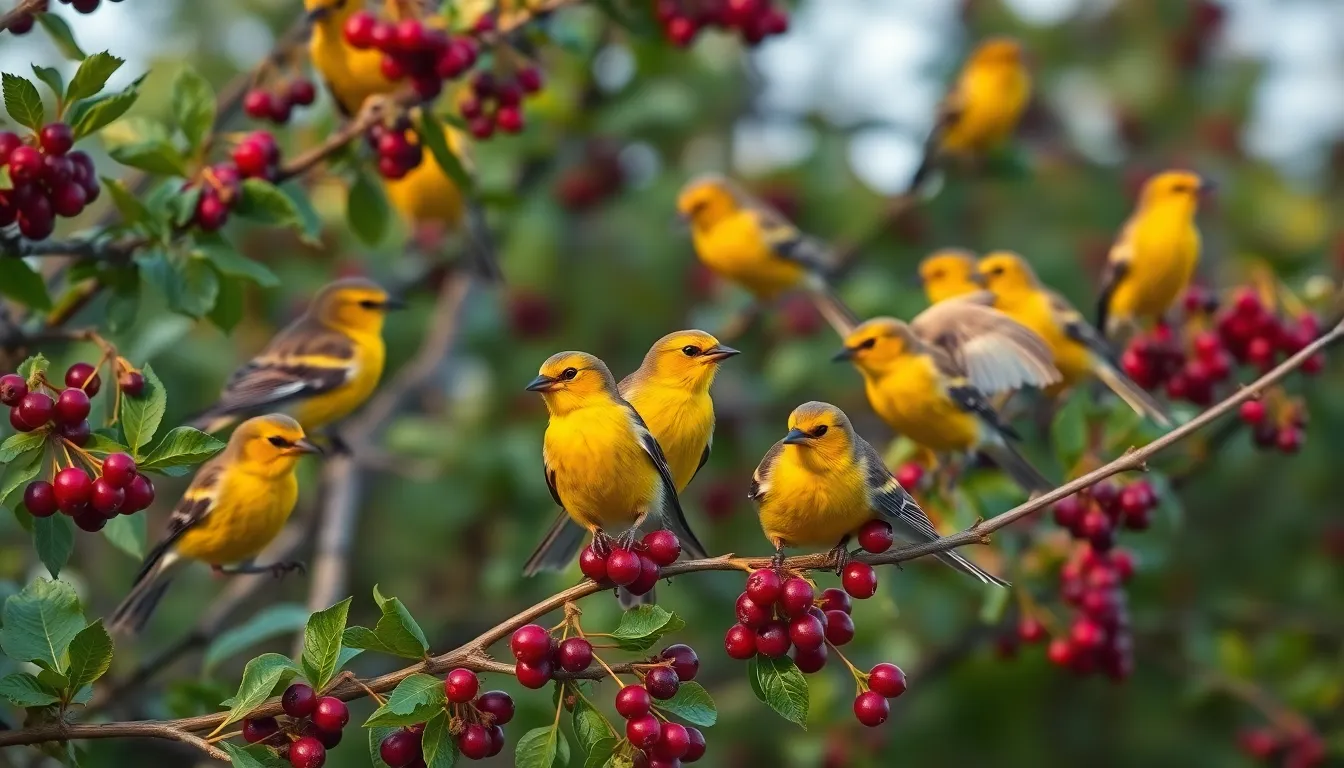
Cedar waxwings showcase one of nature’s most fruit-focused diets among North American songbirds. These elegant birds consume primarily fruits throughout the year, making them exceptional frugivores in the avian industry.
Primary Food Sources
Fruits comprise 85% of the cedar waxwing’s annual diet, with berries from native trees and shrubs forming their nutritional foundation. We observe these birds targeting exact fruiting species including serviceberries, elderberries, dogwood berries, and mountain ash fruits during summer months.
Cedar waxwings consume insects primarily during breeding season from May through July, when protein demands increase for reproduction. Flying insects such as mayflies, scale insects, beetles, and caterpillars provide essential nutrients for egg production and chick development.
Seasonal Diet Composition:
| Season | Fruits | Insects | Primary Food Sources |
|---|---|---|---|
| Spring | 70% | 30% | Serviceberries, flying insects |
| Summer | 65% | 35% | Elderberries, caterpillars |
| Fall | 95% | 5% | Mountain ash, dogwood berries |
| Winter | 98% | 2% | Persistent berries, rare insects |
Cultivated fruits attract cedar waxwings to orchards and gardens, where they feed on cherries, grapes, apples, and ornamental crabapples. These birds show particular preference for overripe or fermented fruits, which sometimes leads to intoxication behaviors.
Unique Feeding Habits and Social Eating
Cedar waxwings demonstrate remarkable cooperative feeding behaviors rarely seen in other songbird species. Flocks of 20 to 200 individuals coordinate their feeding activities, often moving through fruiting trees in synchronized waves.
Line feeding represents the most distinctive social behavior among cedar waxwings, where birds perch in rows and pass berries from one individual to another before consumption. This courtship ritual occurs between mated pairs but extends to flock members during abundant food periods.
Groups strip entire trees of fruit within hours, consuming berries at rates exceeding 1,000 fruits per bird per day during peak feeding times. We document flocks remaining in exact locations for 3 to 7 days until local fruit supplies become depleted.
Cedar waxwings regurgitate berry seeds throughout their feeding areas, making them crucial seed dispersers for native plant communities. Each bird processes 300 to 500 berries daily during autumn migration, depositing viable seeds across distances exceeding 50 miles.
Nomadic movement patterns follow fruit availability rather than traditional migration routes, causing flocks to appear unpredictably in regions with exceptional berry crops. These irruptive movements can bring thousands of cedar waxwings to areas where they’re typically uncommon, creating spectacular feeding congregations that last several weeks.
Breeding and Reproduction
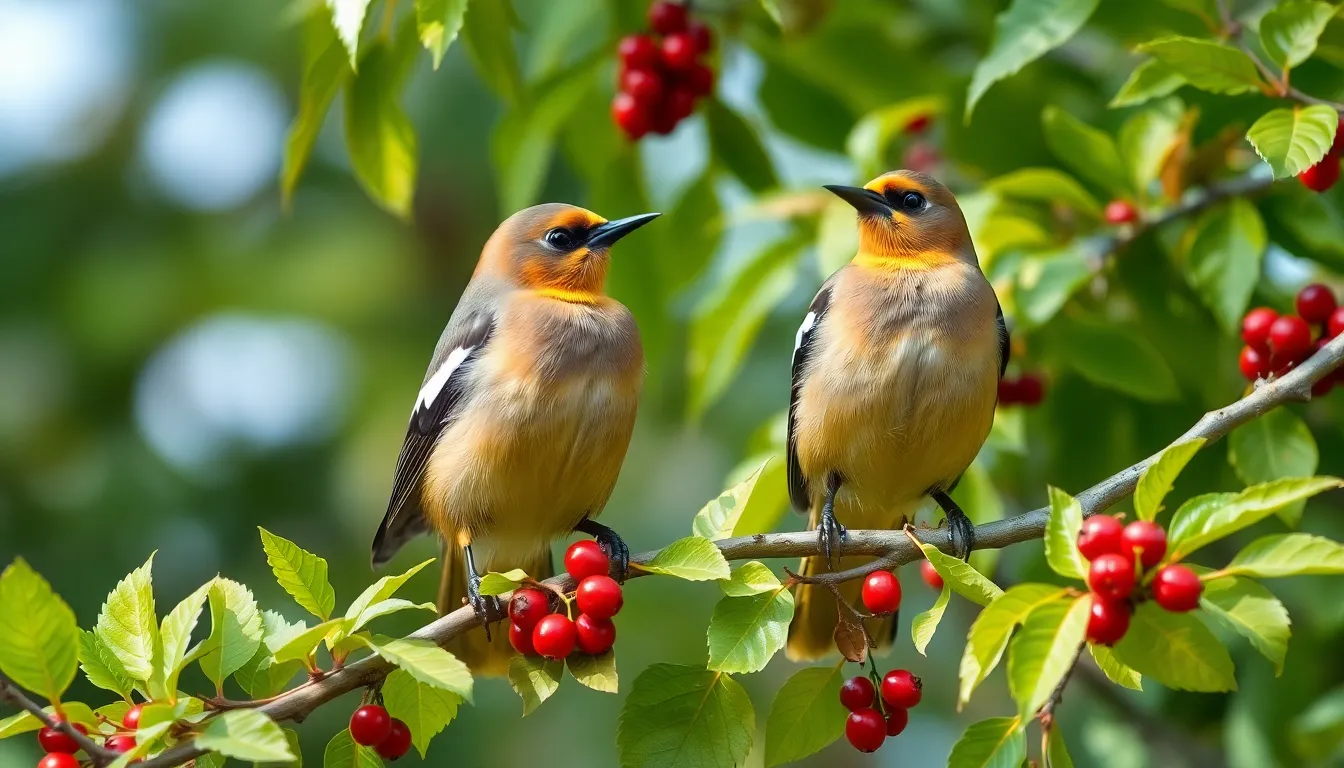
Cedar waxwings demonstrate fascinating reproductive behaviors that set them apart from other songbirds. Their breeding patterns align closely with fruit ripening cycles rather than traditional seasonal timing.
Nesting Behavior and Mate Selection
Cedar waxwings begin courtship rituals between May and August across their breeding range. Males initiate courtship by performing a distinctive side-hopping dance while offering berries or small insects to potential mates. This berry-passing behavior often continues throughout the courtship period and strengthens pair bonds.
Pairs select nesting sites in horizontal branches or forks of trees, typically positioning nests 6 to 20 feet above ground. Both partners participate in nest construction, building a cup-shaped structure using twigs, grass, pine needles, and plant fibers. The female completes the interior lining with fine materials like rootlets and animal hair.
Cedar waxwings exhibit strong territorial behaviors during nesting season, defending areas within 50 to 100 feet of their nest site. Males perform aerial displays and chase away intruders while females focus primarily on nest building activities. Monogamous pairs remain together throughout the breeding season and often produce multiple broods when food sources remain abundant.
Egg Laying and Chick Development
Female cedar waxwings lay 3 to 5 pale blue-gray eggs with dark spots concentrated at the larger end. Incubation lasts 12 to 14 days with females handling primary brooding duties while males provide regular food deliveries to the nest.
Newly hatched chicks remain in the nest for 14 to 18 days during the nestling period. Both parents feed young birds a diet consisting primarily of insects during the first week, gradually introducing mashed fruits as chicks develop. Parent birds make 20 to 30 feeding trips per day to meet the high energy demands of growing nestlings.
Fledgling cedar waxwings continue receiving parental care for 6 to 10 days after leaving the nest. Young birds develop their characteristic waxy red wing tips during their first molt, typically occurring 3 to 4 months after hatching. Juvenile cedar waxwings reach reproductive maturity during their second year, though some individuals may breed successfully during their first breeding season if environmental conditions prove favorable.
Social Behavior and Flocking Patterns
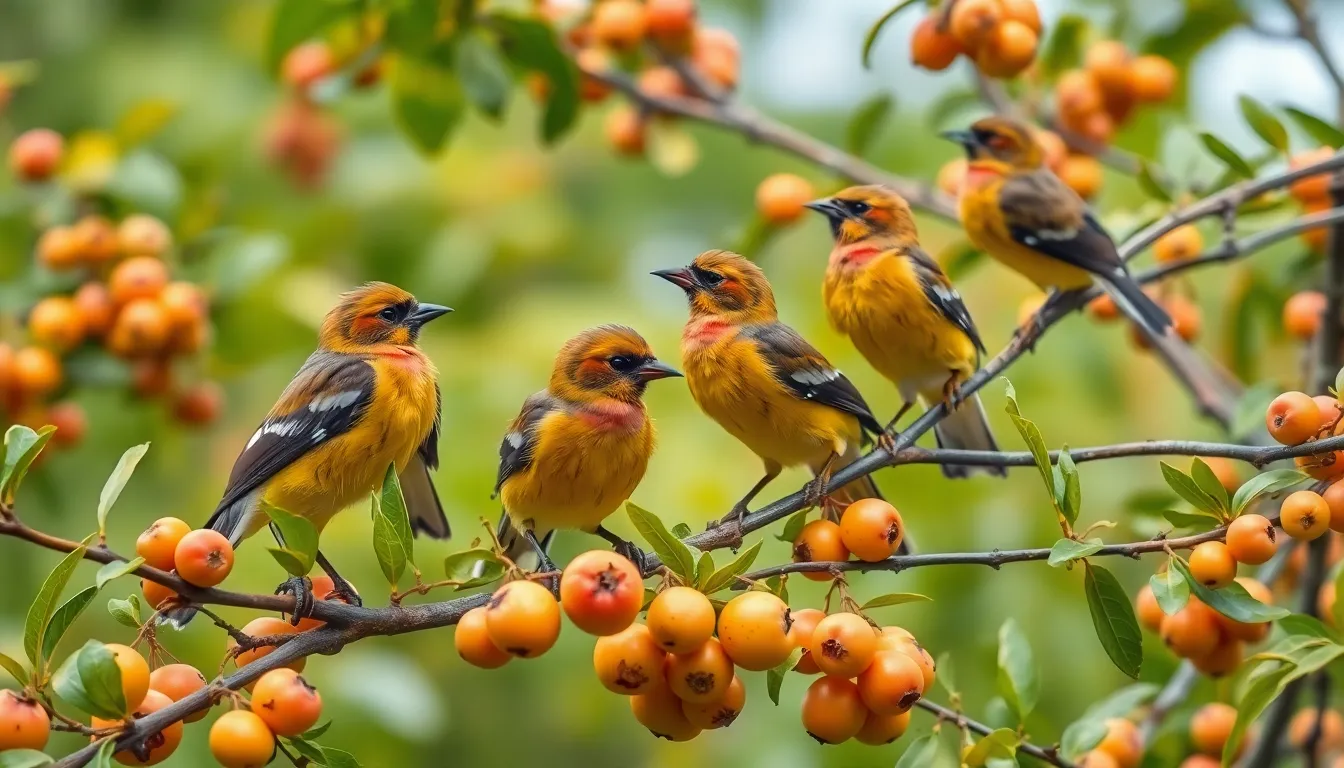
Cedar waxwings demonstrate remarkable social cohesion throughout their lives, forming tight-knit flocks that can range from small family groups to massive congregations of several hundred birds. These social structures define their survival strategy and create one of nature’s most coordinated bird communities.
Group Dynamics and Communication
Cedar waxwings communicate through a sophisticated system of high-pitched calls and visual cues that maintain flock unity across vast distances. Their primary vocalizations consist of thin, whistling “seee” notes that carry up to 200 meters in open terrain.
Flocking hierarchies emerge based on age and breeding experience, with adult birds leading younger individuals to productive feeding sites. Dominant birds occupy prime positions during feeding, typically claiming the most fruit-laden branches while subordinate members follow established patterns.
Contact calls increase in frequency when flocks exceed 50 individuals, ensuring stragglers remain connected to the main group. Cedar waxwings also employ subtle body language including head tilting and wing positioning to communicate feeding intentions and territorial boundaries within the flock.
Their cooperative feeding behaviors include the famous berry-passing ritual where birds form lines and pass fruits beak to beak down the row. This behavior strengthens social bonds and ensures efficient food distribution among flock members, particularly benefiting juvenile birds still developing foraging skills.
Seasonal Behavioral Changes
Winter flocking patterns intensify as cedar waxwings form mega-flocks containing 200 to 500 birds that move nomadically across the industry. These large congregations break apart during breeding season when pairs establish territories spanning 0.5 to 2 acres.
Spring behavior shifts dramatically as hormonal changes trigger courtship displays and territorial defense mechanisms. Males become increasingly vocal and perform elaborate hopping dances while females evaluate potential mates based on berry-offering rituals and nest site quality.
Summer social structures revolve around family units, with parents and offspring maintaining close contact through exact parent-young calls. Fledgling cedar waxwings remain with their parents for 14 to 18 days after leaving the nest, learning crucial foraging techniques through observation and mimicry.
Autumn brings renewed flocking intensity as families merge into larger groups preparing for winter movements. Cedar waxwings exhibit increased restlessness during this period, with flocks conducting reconnaissance flights to locate fruit-rich territories before committing to extended stays.
Cedar Waxwing vs Similar Species
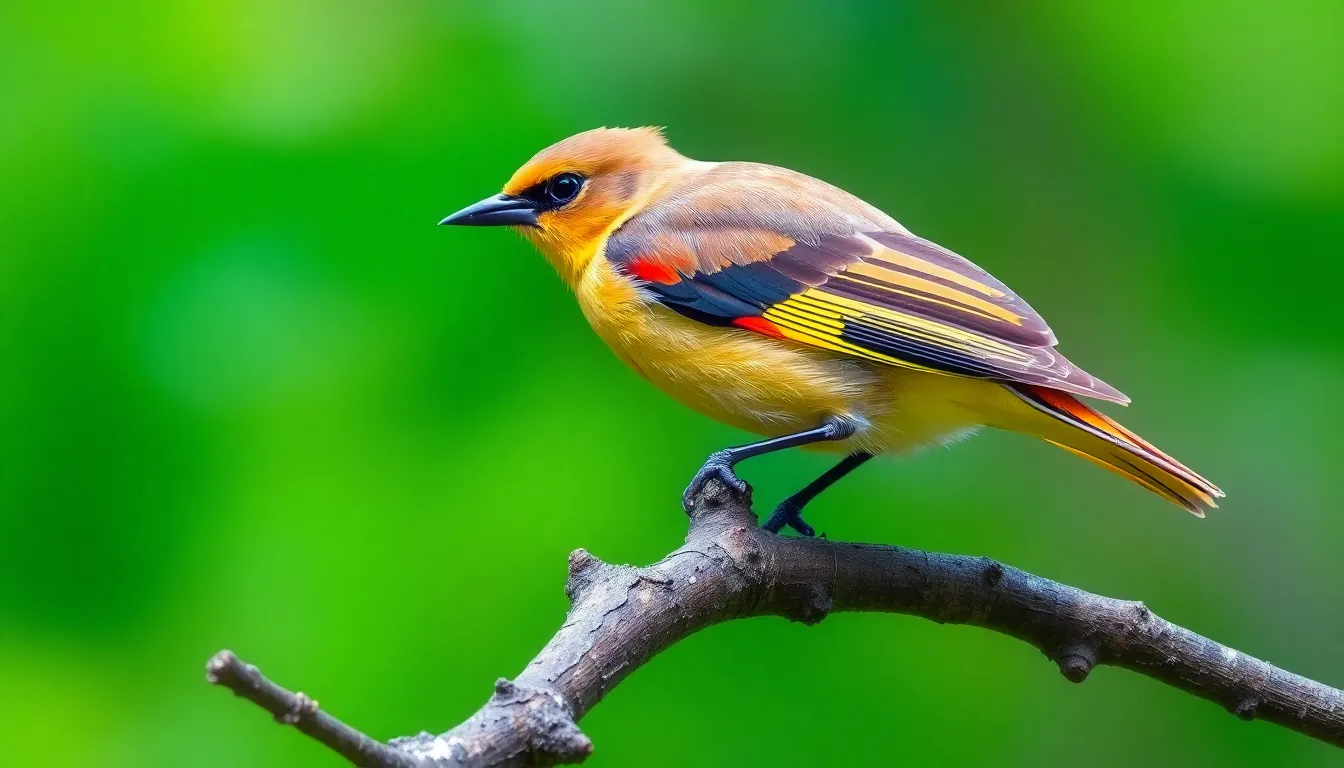
Identifying cedar waxwings becomes easier when we understand how they differ from closely related species and other birds with similar characteristics. We can distinguish these elegant birds through exact physical features, behavioral patterns, and habitat preferences.
Key Differences from Bohemian Waxwings
Bohemian waxwings represent the most similar species to cedar waxwings, yet several distinct characteristics separate these two waxwing family members. Size provides the most immediate distinguishing factor, with Bohemian waxwings measuring 8 inches in length compared to cedar waxwings’ 6.5 to 7 inches.
Coloration patterns differ significantly between the species. Bohemian waxwings display rusty red undertail coverts and white wing markings that cedar waxwings completely lack. We notice cedar waxwings maintain their pale yellow breast coloration, while Bohemian waxwings show gray breasts with rusty flanks.
Geographic distribution creates another reliable identification method. Cedar waxwings inhabit areas throughout North America, whereas Bohemian waxwings primarily occupy northern regions of Canada and Alaska. Migration patterns show Bohemian waxwings traveling south only during harsh winters, making cedar waxwings the more commonly observed species in most regions.
Wing tip markings appear on both species but differ in extent. Bohemian waxwings possess waxy red tips on both primary and secondary flight feathers, while cedar waxwings display these distinctive markings only on their secondary feathers.
Distinguishing Features from Other Birds
Cedar waxwings share superficial similarities with several bird species, particularly in size and coloration, but unique features make identification straightforward. Mockingbirds exhibit similar gray brown plumage but lack the distinctive black eye mask and waxy red wing tips that characterize cedar waxwings.
Cardinals present potential confusion due to their crested appearance, yet their bright red coloration and robust bill structure differ markedly from cedar waxwings’ subtle earth tones and pointed bills. Female cardinals show brown coloration but maintain the characteristic thick seed cracking bill that cedar waxwings don’t possess.
| Feature | Cedar Waxwing | Mockingbird | Cardinal | Bohemian Waxwing |
|---|---|---|---|---|
| Length | 6.5-7 inches | 8-10 inches | 8.5-9 inches | 8 inches |
| Crest | Pointed | None | Prominent | Pointed |
| Wing markings | Red waxy tips | White patches | None | Red waxy tips + white |
| Undertail | Yellow | White | Red/brown | Rusty red |
Jay species create identification challenges due to their crested heads and similar body proportions. Blue jays display obvious blue coloration with white underparts, while cedar waxwings maintain their characteristic brown and yellow palette. We observe that jays exhibit aggressive territorial behavior contrasting with cedar waxwings’ cooperative social nature.
Flycatcher species, particularly the cedar flycatcher, share habitat preferences with cedar waxwings but demonstrate distinct behavioral differences. Flycatchers perch alone and dart out to catch insects, whereas cedar waxwings travel in flocks and primarily consume fruits. Bill shape provides another distinction, with flycatchers possessing broader, flatter bills adapted for catching flying insects.
Cedar waxwings’ unique tail band appears as a bright yellow stripe across the tail tip, distinguishing them from virtually all other North American bird species. This marking, combined with their silky plumage texture and nomadic flocking behavior, creates an unmistakable identification profile that experienced and novice birdwatchers can recognize.
Conservation Status and Threats
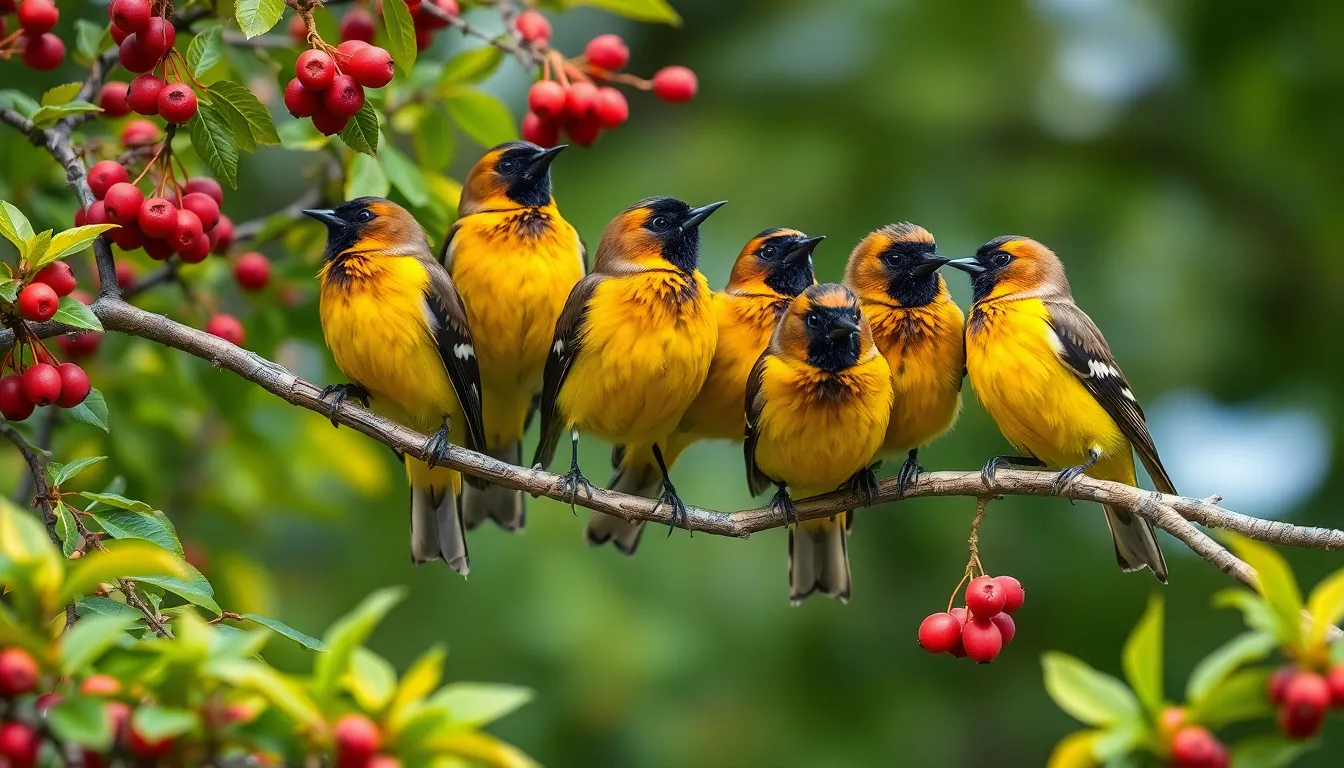
Cedar waxwings maintain stable populations across North America even though facing various environmental pressures. These resilient birds currently hold a conservation status of Least Concern according to the International Union for Conservation of Nature.
Population Trends and Environmental Challenges
Cedar waxwing populations demonstrate remarkable stability with an estimated 54 million breeding adults across their range. Breeding Bird Survey data from 1966 to 2019 shows population fluctuations remain within normal parameters with no important declining trends.
Climate change presents the primary long-term challenge for cedar waxwing conservation. Rising temperatures alter fruit ripening cycles, disrupting the synchronized timing between breeding seasons and peak food availability. Extreme weather events during nesting periods cause reproductive failures, particularly when late spring frosts destroy fruit crops that sustain breeding pairs.
Habitat fragmentation affects cedar waxwing populations through the loss of native fruiting trees and shrubs. Urban development removes critical food sources like elderberry thickets and mountain ash groves that support large flocks during winter months. Agricultural practices eliminate hedgerows and woodland edges where these birds traditionally forage and nest.
Window strikes account for important cedar waxwing mortality in suburban areas where they frequent ornamental fruit trees. Their flocking behavior increases collision risks as entire groups follow flight paths near glass surfaces. Pesticide exposure threatens cedar waxwings through contaminated fruits and insects, affecting their reproductive success and nestling survival rates.
Human Impact and Protection Efforts
Human activities create both positive and negative impacts on cedar waxwing populations throughout their range. Native plant restoration projects benefit these birds by establishing fruiting species like serviceberry and elderberry in parks and green spaces. Suburban landscaping with berry-producing trees provides supplemental food sources, particularly during harsh winter conditions.
Conservation organizations carry out targeted protection strategies for cedar waxwing habitats. The North American Bird Conservation Initiative identifies maintaining diverse fruit resources as a priority action for sustaining stable populations. Land management practices now emphasize preserving native shrublands and forest edge habitats that produce the fruits cedar waxwings depend on year-round.
Bird-friendly building design reduces window strike mortality through the installation of visible markers and strategic glass placement. Public education campaigns teach homeowners to plant native fruiting species and maintain pesticide-free landscapes. Community science programs like eBird and Christmas Bird Counts provide essential population monitoring data that guides conservation decisions.
Collaborative efforts between wildlife agencies and private landowners create habitat corridors connecting fragmented forest patches. These initiatives focus on establishing continuous bands of fruiting vegetation that support nomadic cedar waxwing movements across landscapes. Forest management plans increasingly incorporate cedar waxwing habitat requirements by maintaining diverse age structures of fruit-producing trees and shrubs.
Birdwatching Tips for Cedar Waxwings
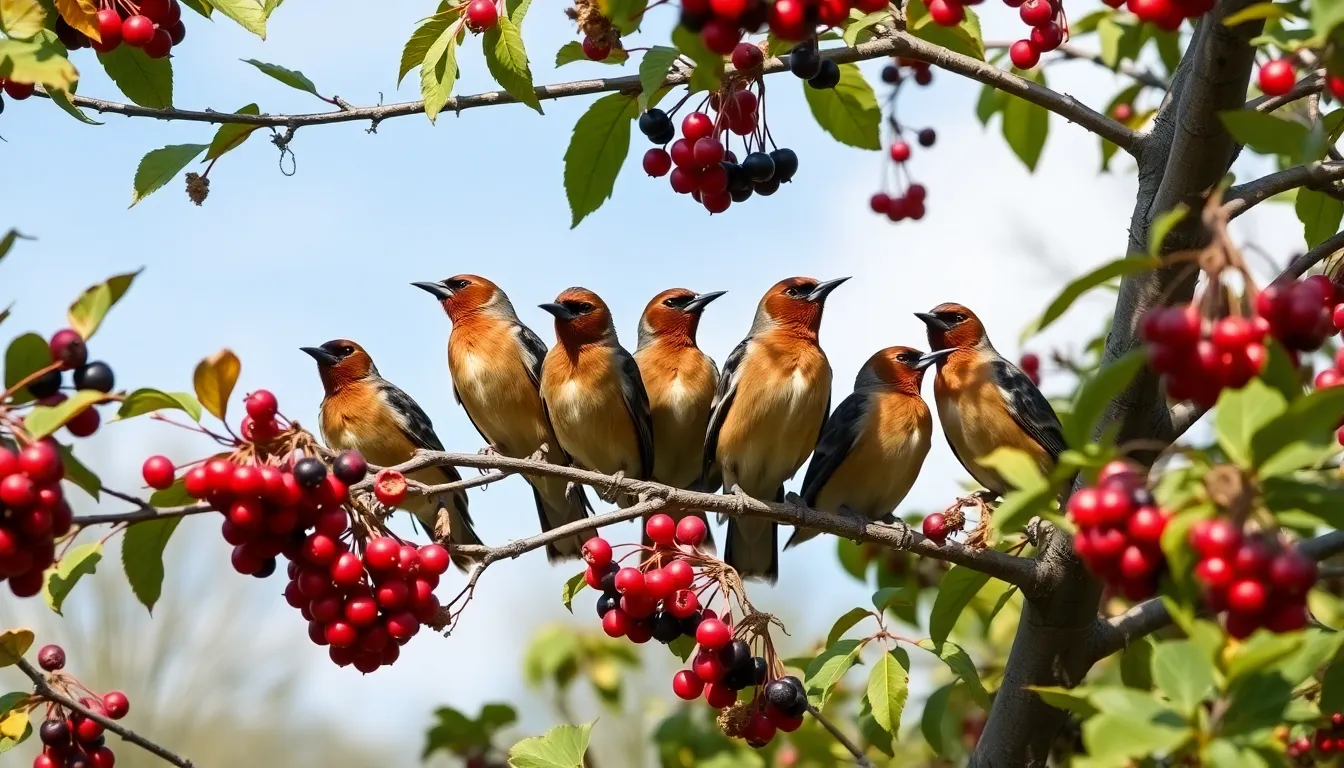
Cedar waxwing observation requires understanding their nomadic movement patterns and fruit-focused feeding preferences. Successful sightings depend on timing visits with local berry seasons and knowing their preferred habitats.
Best Times and Locations for Spotting
Cedar waxwings appear most frequently during berry ripening seasons from late summer through early winter. Peak observation opportunities occur between August and November when native fruits like elderberries and serviceberries reach maturity across their range.
Morning hours between 7 AM and 10 AM provide optimal viewing conditions as cedar waxwings engage in active feeding before temperatures rise. Flocks often remain stationary for 30 to 45 minutes while systematically harvesting fruit from individual trees.
Urban parks with diverse fruiting trees offer excellent spotting locations, particularly those containing mountain ash, crabapple, and ornamental cherry varieties. Golf courses and suburban neighborhoods with mature landscaping frequently host feeding flocks throughout autumn months.
Wetland edges and riparian corridors support concentrated populations during migration periods. Listen for their distinctive high-pitched “seee” calls which often indicate nearby flocks before visual confirmation occurs.
Winter sightings increase dramatically in areas with persistent fruit sources like rose hips and winterberry. Cedar waxwings form mega-flocks of 200 to 500 individuals during harsh weather conditions, making detection easier even though reduced daylight hours.
Attracting Cedar Waxwings to Your Yard
Native fruiting trees and shrubs create the foundation for successful cedar waxwing attraction. Plant elderberry bushes, serviceberry trees, and dogwood varieties to establish reliable food sources throughout their preferred feeding seasons.
Multiple fruit species ensure extended visitation periods as different plants ripen sequentially from summer through winter. Cedar waxwings consume over 1,000 fruits per bird daily during peak feeding, requiring substantial fruit production to support even small flocks.
Water features enhance yard attractiveness, particularly shallow birdbaths with moving water elements. Cedar waxwings drink frequently and use water sources for bathing, especially after consuming sticky or sugary fruits.
Avoid pesticide applications near fruiting plants as cedar waxwings consume both fruits and insects throughout the growing season. Chemical treatments reduce insect availability and potentially harm birds through secondary poisoning.
Create fruit clusters by planting trees in groups rather than individual specimens. Cedar waxwings exhibit strong preferences for concentrated food sources and often bypass scattered plantings in favor of dense fruiting areas.
Maintain fruit on branches throughout winter months instead of removing fallen or overripe specimens. Late-season fruits provide critical nutrition during harsh weather when other food sources become unavailable.
Conclusion
Cedar waxwings continue to captivate bird enthusiasts with their remarkable adaptability and social nature. These elegant birds demonstrate that success in the avian industry doesn’t always follow conventional patterns – their fruit-focused lifestyle and nomadic movements set them apart from typical songbirds.
By understanding their behaviors and habitat preferences we can better appreciate the important ecological role cedar waxwings play in our ecosystems. Their seed dispersal activities help maintain healthy plant communities while their cooperative feeding behaviors showcase nature’s collaborative spirit.
Whether you’re planning your first cedar waxwing observation or you’re already familiar with these charming birds the key lies in patience and knowing where to look. With stable populations and widespread distribution these remarkable birds will continue to reward observers who take the time to seek them out during berry season.
Frequently Asked Questions
What do cedar waxwings look like?
Cedar waxwings are elegant birds measuring 6.5-7 inches long with silky brown plumage, pale yellow breasts, and distinctive black eye masks. Their most notable feature is the waxy red wing tips that give them their name. Adults have crested heads and maintain consistent coloring year-round, while juveniles show streaked underparts and lack the red wing tips.
Where can I find cedar waxwings?
Cedar waxwings inhabit diverse environments across North America, from southeastern Alaska through Canada to the northern United States. They prefer open woodlands, parks, suburban areas, and anywhere with abundant fruiting trees. Unlike typical songbirds, they move nomadically based on food availability rather than following predictable migration routes.
What do cedar waxwings eat?
Cedar waxwings have a fruit-focused diet comprising 85% of their annual intake. They primarily consume serviceberries, elderberries, and mountain ash fruits. During breeding season, they increase insect consumption for protein. These birds can eat over 1,000 fruits per day and play a crucial role in seed dispersal for native plants.
When do cedar waxwings breed?
Cedar waxwings breed between May and August, timing their reproduction with fruit ripening cycles rather than traditional seasons. Males perform courtship rituals including side-hopping dances and berry offerings. Females lay 3-5 pale blue-gray eggs, with both parents participating in nest building and chick care for 12-14 days of incubation.
How do cedar waxwings behave socially?
Cedar waxwings are highly social birds that form tight-knit flocks ranging from small family groups to hundreds of individuals. They exhibit unique cooperative feeding behaviors, including “line feeding” where they pass berries among flock members. Their social structure includes hierarchies based on age and breeding experience, with dominant birds leading others to food sources.
How can I attract cedar waxwings to my yard?
To attract cedar waxwings, plant native fruiting trees and shrubs like serviceberry, elderberry, and mountain ash. Maintain clean water sources and avoid pesticide use. The best viewing times are during berry seasons from late summer through early winter, particularly August through November, with morning hours being optimal for observation.
What’s the difference between cedar waxwings and Bohemian waxwings?
Cedar waxwings are smaller than Bohemian waxwings and have pale yellow breasts compared to the rusty-orange coloring of Bohemians. Cedar waxwings have limited waxy red wing tips, while Bohemians display more extensive waxy markings. Geographic distribution also differs, with cedar waxwings having a broader North American range.
Are cedar waxwings endangered?
Cedar waxwings are currently classified as Least Concern with stable populations of approximately 54 million breeding adults across North America. However, they face challenges from climate change affecting fruit ripening cycles, habitat fragmentation, window strikes, and pesticide exposure. Conservation efforts focus on maintaining diverse fruit resources and habitat corridors.

